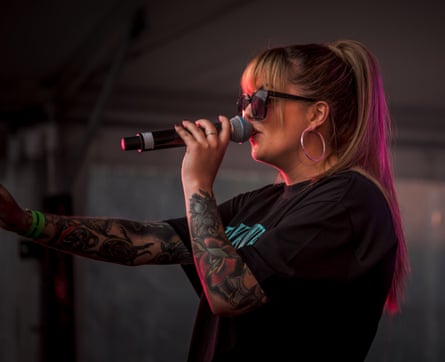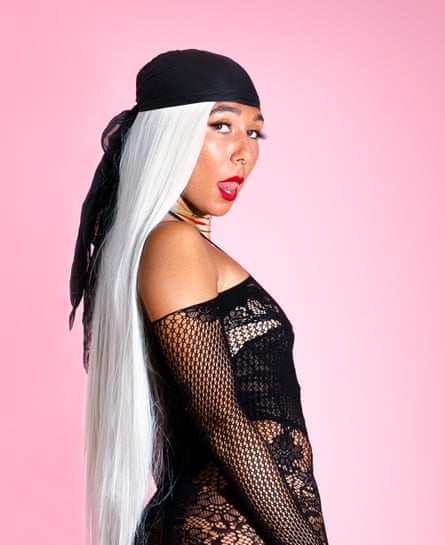Australia’s female First Nations rappers turn pain into power | Music
When the Indigenous hip-hop artist Charmaine Jasmine Armstrong – also known as Dizzy Doolan – started spitting rhymes 22 years ago she was one of a handful of women in Australia’s rap scene.
There was no one to teach her how to put songs together, promote herself, apply for grants or even upload music. In the early 2000s the Australian scene was dominated by white men – groups like the Hilltop Hoods.
“There was no other female rappers that I knew of really doing their thing,” Dizzy says. “There was no one to look up to, apart from your American groups.”
Two decades later Dizzy is part of a growing number of Indigenous female artists across Australia. They are merging the world’s oldest living cultures with a comparatively new genre of music: rap. They’re also ushering in a new wave of hip-hop that wrestles with racial politics, Australia’s bloody past and social injustice.
In far north Queensland, Dizzy, a Takalak, Agwamin, Gureng Gureng and Wokka Wokka woman, grew up listening to jazz and blues. At 16 she released her first rap song, No Shame – a message about not letting that feeling hold you back.
“My mum’s sister passed away, so I was at a very down point,” she says. “When I discovered songwriting and rap, I was like, ‘Oh, I can put on my pain and struggle and make it sound cool.’ Turning your pain to power.”
At 18 she recorded her first song on to CDs and would walk the streets of Brisbane, putting them into letterboxes.
“I was like, ‘How can we get this music out?’ I had no iTunes, there was nothing like that – we barely had access to the internet.
“But the beauty about hip-hop is you only need a pen and paper. I started with no beat, just banging on the table.”
As mainstream Australia’s taste for rap developed, so did Dizzy’s career. From chasing small gigs in Brisbane she went on to support huge international artists including Fatman Scoop, T-Pain and Akon. Now 38, Dizzy has just released her first full album.
“I wasn’t valued as much as a male would be in the industry,” she says. “But then, you use that, you take that and you use that as power, and prove them wrong.
“Nowadays there’s a big movement of more female artists in the scene, which I’m so excited to see.”
‘We’re seeing the flowers’
Grant Saunders, a film-maker from Biripi country, wrote his PhD on the art form and says Indigenous Australians have embraced and created hip-hop since the 80s.
“[Hip-hop coming out of the United States] was telling stories that were parallel to the stories that we grew up with,” he says. “Police violence, harassment, over-incarceration, poverty. It resonated with us.”

It wasn’t until 2001 that the Wiradjuri and African American woman Ebony Williams became the first Indigenous rapper to have a song professionally recorded and played on air, Saunders said. “That was hugely inspirational for a lot of people,” he says.
“There were really two communities that existed in the hip-hop scene back then … there was an Indigenous multicultural scene where everyone knew each other. And then there was the Aussie hip-hop scene … which was fairly white.”
He said early pioneers in the 2000s paved the way for today’s artists. “They’ve sown the seeds and now we’re seeing the flowers,” he says.
‘The last peaceful protest we have’
The Launceston-based First Nations artist Denni Proctor, AKA DENNI/Madam pakana says she fell into making hip-hop music.
A descendent of the Indigenous warrior Mannalargenna, she often wrestles with Tasmania’s colonial history. “They want a war, don’t want to talk about a massacre,” she raps in Strongest Mob.
She uses music as a vehicle for truth-telling and healing, both for herself and for Tasmanian communities.
“Hip-hop has its own culture,” she says. “It’s very word-driven, it’s people out the front saying it how it is. Music is the last peaceful protest we have.”

Growing up in the seaside town of Ceduna, South Australia, the Kokatha-Greek artist Crystal Clyne Mastrosavas, AKA Lady Lash, fell in love with the lyrics of Tupac Shakur.
“I heard 2Pac and, wow, I got into it,” she says. “I resonated with his lyrics and flow – it was mind-blowing,” she says.
In 2009 her single 7 Deadly Sins was picked up by Triple J, which “just launched me as an artist”, Lash says.
Her music combines hip-hop and jazz, melding her Indigenous and Greek heritage into soulful, powerful lyrics about living with racism, intergenerational trauma and wrestling with motherhood while pursuing a music career.

“I just fell in love with the music,” she says. “I felt limerence with music, and love and life.”
Struggling with backlash
Many female hip-hop artists have found their success has been tainted by racism. Miss Kaninna, who is of Yorta Yorta, Djadja Wurrung, Kalkadoon and Yirendali heritage, knows this well.
The artist was crowned the 2023 Unearthed artist of the year for her single Blak Britney, which shot to number one on Triple J within a fortnight of its release.
“I’ve had so many positive things birthed out of releasing Blak Britney, but I’ve also experienced more racism in the past eight months than I ever have in almost my entire life,” she says.
Miss Kaninna says the backlash is exhausting – but it drives her to make more music.
“Indigenous people have found a way to weaponise their voice that can reach farther,” she says. “Like, if you thought the Blak Britney or Pinnacle Bitch was hectic, like these motherfuckers aren’t even ready.”
When the Indigenous hip-hop artist Charmaine Jasmine Armstrong – also known as Dizzy Doolan – started spitting rhymes 22 years ago she was one of a handful of women in Australia’s rap scene.
There was no one to teach her how to put songs together, promote herself, apply for grants or even upload music. In the early 2000s the Australian scene was dominated by white men – groups like the Hilltop Hoods.
“There was no other female rappers that I knew of really doing their thing,” Dizzy says. “There was no one to look up to, apart from your American groups.”
Two decades later Dizzy is part of a growing number of Indigenous female artists across Australia. They are merging the world’s oldest living cultures with a comparatively new genre of music: rap. They’re also ushering in a new wave of hip-hop that wrestles with racial politics, Australia’s bloody past and social injustice.
In far north Queensland, Dizzy, a Takalak, Agwamin, Gureng Gureng and Wokka Wokka woman, grew up listening to jazz and blues. At 16 she released her first rap song, No Shame – a message about not letting that feeling hold you back.
“My mum’s sister passed away, so I was at a very down point,” she says. “When I discovered songwriting and rap, I was like, ‘Oh, I can put on my pain and struggle and make it sound cool.’ Turning your pain to power.”

At 18 she recorded her first song on to CDs and would walk the streets of Brisbane, putting them into letterboxes.
“I was like, ‘How can we get this music out?’ I had no iTunes, there was nothing like that – we barely had access to the internet.
“But the beauty about hip-hop is you only need a pen and paper. I started with no beat, just banging on the table.”
As mainstream Australia’s taste for rap developed, so did Dizzy’s career. From chasing small gigs in Brisbane she went on to support huge international artists including Fatman Scoop, T-Pain and Akon. Now 38, Dizzy has just released her first full album.
“I wasn’t valued as much as a male would be in the industry,” she says. “But then, you use that, you take that and you use that as power, and prove them wrong.
“Nowadays there’s a big movement of more female artists in the scene, which I’m so excited to see.”
‘We’re seeing the flowers’
Grant Saunders, a film-maker from Biripi country, wrote his PhD on the art form and says Indigenous Australians have embraced and created hip-hop since the 80s.
“[Hip-hop coming out of the United States] was telling stories that were parallel to the stories that we grew up with,” he says. “Police violence, harassment, over-incarceration, poverty. It resonated with us.”

It wasn’t until 2001 that the Wiradjuri and African American woman Ebony Williams became the first Indigenous rapper to have a song professionally recorded and played on air, Saunders said. “That was hugely inspirational for a lot of people,” he says.
“There were really two communities that existed in the hip-hop scene back then … there was an Indigenous multicultural scene where everyone knew each other. And then there was the Aussie hip-hop scene … which was fairly white.”
He said early pioneers in the 2000s paved the way for today’s artists. “They’ve sown the seeds and now we’re seeing the flowers,” he says.
‘The last peaceful protest we have’
The Launceston-based First Nations artist Denni Proctor, AKA DENNI/Madam pakana says she fell into making hip-hop music.
A descendent of the Indigenous warrior Mannalargenna, she often wrestles with Tasmania’s colonial history. “They want a war, don’t want to talk about a massacre,” she raps in Strongest Mob.
She uses music as a vehicle for truth-telling and healing, both for herself and for Tasmanian communities.
“Hip-hop has its own culture,” she says. “It’s very word-driven, it’s people out the front saying it how it is. Music is the last peaceful protest we have.”

Growing up in the seaside town of Ceduna, South Australia, the Kokatha-Greek artist Crystal Clyne Mastrosavas, AKA Lady Lash, fell in love with the lyrics of Tupac Shakur.
“I heard 2Pac and, wow, I got into it,” she says. “I resonated with his lyrics and flow – it was mind-blowing,” she says.
In 2009 her single 7 Deadly Sins was picked up by Triple J, which “just launched me as an artist”, Lash says.
Her music combines hip-hop and jazz, melding her Indigenous and Greek heritage into soulful, powerful lyrics about living with racism, intergenerational trauma and wrestling with motherhood while pursuing a music career.

“I just fell in love with the music,” she says. “I felt limerence with music, and love and life.”
Struggling with backlash
Many female hip-hop artists have found their success has been tainted by racism. Miss Kaninna, who is of Yorta Yorta, Djadja Wurrung, Kalkadoon and Yirendali heritage, knows this well.
The artist was crowned the 2023 Unearthed artist of the year for her single Blak Britney, which shot to number one on Triple J within a fortnight of its release.
“I’ve had so many positive things birthed out of releasing Blak Britney, but I’ve also experienced more racism in the past eight months than I ever have in almost my entire life,” she says.
Miss Kaninna says the backlash is exhausting – but it drives her to make more music.
“Indigenous people have found a way to weaponise their voice that can reach farther,” she says. “Like, if you thought the Blak Britney or Pinnacle Bitch was hectic, like these motherfuckers aren’t even ready.”
